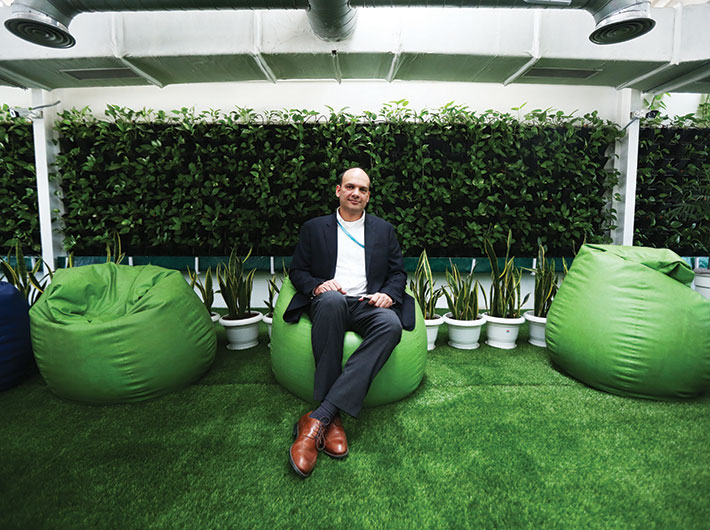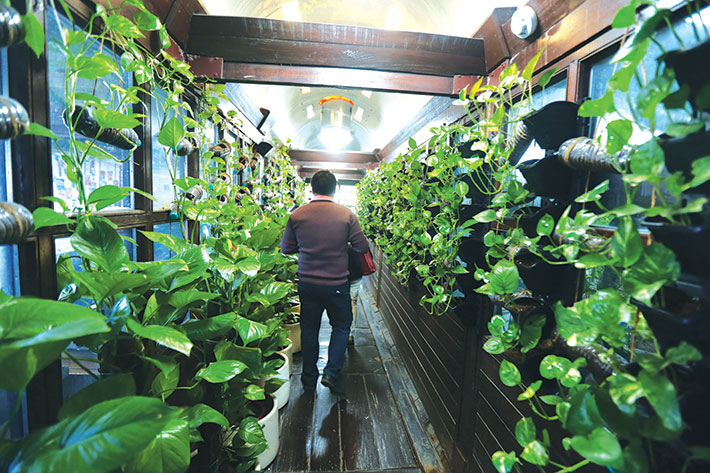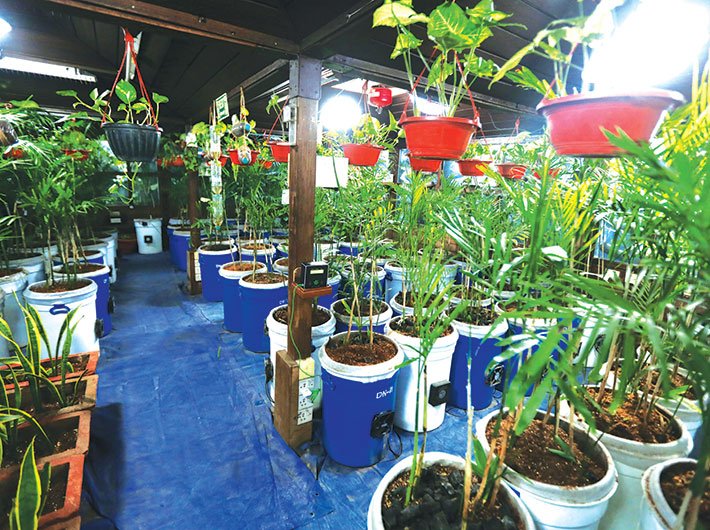Walking along the row of multistory buildings swathed in a haze of pollution at the Nehru Place business hub in South Delhi, when you come across what looks like a forest, you are just outside India’s first office complex which has air as fresh as in Gulmarg or Davos. Paharpur Business Centre (PBC), an office complex, is the brainchild of Kamal Meattle, a scientist-turned-businessman. Asked by his doctors to leave Delhi in 1992 – to avoid the city’s toxic air, Meattle decided to manufacture pure air inside his work premises. Thus began the conversion of PCB’s premises – a six-floor, 6,000 square feet building – into an oasis with mountain-quality air in the centre of Delhi, known for its highly polluted air. It took some 7,000 plants to achieve the transformation. PBC has since been rated the healthiest office building in Delhi. For its energy conservation, it has been given the tag of Certified LEED Platinum building by the US green building council (USGBC) and also rated as BEE 5-star building. Meattle’s Ted Talk on ‘How to Grow Your Own Fresh Air’, based on his experiment at PBC, has registered more than three million views. The building is now seen as a green business model. Meattle’s son-in-law Barun Aggarwal, CEO of Breath Easy Consultants, looks after the group’s business of green buildings. He spoke to us about how PBC is able to make the mountain quality air.

How did the idea of creating a building with mountain-quality air come up in the first place?
It was 25 years ago when our chairman emeritus, Kamal Meattle, developed an allergy to the pollutants of the Delhi air. His lung capacity was impaired and doctors asked him to leave Delhi. At that time, he was on the board of governors of IIT-Delhi. In one of the governing body meetings, he raised his hands and asked to those present if they were interested in helping him in finding air-purifying technologies. He also told them that there was no budget for it. Being a technologist himself, he got into the project; the first step was to identify pollutants. This was done with the help of imported and very expensive equipment. Even though, back then, pollution was not as severe as it is now, yet the industry, IIT and The Energy Research Institute (TERI), chipped in. Mr Meattle had then learnt that the energy department of the US was trying to experiment with plants to clear the air. Also, at the same time, NASA was doing an experiment on using plants [to support] humans on the space. However, back then, the NASA study was classified and not available to the public. Through his own study, he figured out three commonly found plants which could cleanse the air. These are: the money plant (Epiprenum aureum), mother-in-law’s tongue (Sansevieria trifasciata) and the areca palm (Chrysalidocarpus lutescens). These plants are indigenous, can be grown easily and are easily available. The solution offered was simple; money plants and palms would produce oxygen in the day and mother-in-law’s tongue in the night. With this simple trick of creating a greenhouse in his living space, Mr Meattle’s lungs started getting better within a year or so.
What was his next step?
Next was doing up the PBC and turning it into an office space with the purest air in the country. Having gone through a personal health issue due to pollution, Mr Meattle swung into saving the environment. He set up the ‘Save the Tree Foundation’. It is through the efforts of this body that today apples are packaged in corrugated boxes and not in wooden ones, saving millions of trees. The change was, however, not easy; the foundation had to demonstrate to sellers and farmers that corrugated boxes are a matching alternative to keep the fruit safe. In one demonstration, I remember, a Maruti car was driven over the corrugated sheets to prove that this material is sturdy and therefore good.
What is the most serious pollutant in Delhi’s air?
In the 1990s benzene was one of the most dangerous pollutants in the air in Delhi. But thanks to a public interest litigation (PIL) filed in the early 2000s this was fixed by getting our refineries to produce petrol with 1% benzene instead of the previous 5%. Currently, PM 2.5 is one of the most harmful pollutants in the air as it causes long-term health issues.
How do you clean the air in this building? How do you quantify the cleanliness of the air inside?
Since 90 percent of our working hours are spent inside PBC, the focus is on indoor air quality. First, we remove the suspended particles (PM 2.5) from the air. We wash the ambient air before it enters PBC. We have a particulate matter (PM 2.5) filtration system installed on top of our building which filters noxious gases like sulphur dioxide, nitrous oxide and ozone from the ambient air. This filtered air is allowed inside two huge greenhouses located on the terraces, where it gets oxygenated. The result is mountain-quality air inside the building. The plants are placed in all conceivable spaces all over the building. We are often asked why we have solid wood furniture with the retro look in our building. Not many people would know that the modern-day polished furniture also emits carcinogens. That is why we have teakwood furniture. Companies that hold conferences here have told us that the participants don’t feel sleepy in the post-lunch session because of good oxygen levels generated by the plants.
How do you establish your claims on air quality inside the PBC? What are the health benefits that you have recorded of people working here?
Harvard researcher Prof Joe Allen’s COGfx study says people living in low carbon dioxide environment or green environment have high cognitive functioning scores; their decision-making in crisis is much better. Ours has been declared as the healthiest building in India by the central pollution control board. We have installed the most sophisticated sensors to test the air quality inside PBC. Our air filtration system and greenhouses have brought the air quality inside to a level which is even better than international quality. For example, PM2.5 levels are mostly less than 10 (as against 1,100 microgram/cubic meter); carbon dioxide levels are usually less than 250 ppm over the ambient; the most dangerous oxides of nitrogen, sulphur and ozone are untraceable. Besides, there are long-term benefits: your blood oxygen level going up by one percent (and correspondingly brain and vital organs getting adequate oxygen); eye irritation going down by 52 percent; respiratory symptoms down by 34 percent; headaches by 24 percent; and lung impairment and asthma by 12 percent. Recently, we found that blood pressure levels of people working inside have gone down.

How have you extended the idea?
We are now into the business of helping companies and families having green spaces. So far we have done 8,000 homes in Delhi-NCR alone. But, of course, our clients are ultra-rich people. We are into the international market; in Delhi, we have done the largest mall of Asia, the Select City Mall in Saket, south Delhi, as a green space with good quality air. Also, we have done up the American, the German and the French [embassy] schools in Delhi. We undertake largescale projects of greening spaces on turnkey basis. I am a visiting faculty at the School for Planning and Architecture, Delhi, where I teach students how to create happy and productive spaces. Designing each building is a challenge.
What is the relation between pure air and productivity at workplaces?
There are several scientific studies out there that link human health and wellness with cognitive ability. Since in high carbon dioxide environs, the body and especially the brain (which is 2 percent of body mass and yet uses 30 percent of air inhaled) can’t function properly, humans will be least productive. The COGfx study found that improved indoor environmental quality doubled cognitive function test scores. It also recorded that the largest improvement in cognitive function (in good environs) occurred with crisis response, information usage and strategy. The Harvard study on this found that with lowered carbon dioxide levels coupled with lowered pollutants in buildings, cognitive scores were higher than in conventional buildings. This automatically improves productivity.
With Delhi’s air turning highly toxic, particularly in winters, what scenario are we looking at in the future?
Toxic air impacts our brain – especially its cognitive ability – the most. This has been proven thrrough various studies. Also, various studies have proven beyond doubt that particulate matter (PM2.5) damages the IQ of the human beings. So we have an epidemic on our hands. And the government is only using Band-Aid solutions to fix the massive problem.
How do people using your building for office work feel when they are suddenly introduced to mountain-quality air indoors?
Our clients tell us about the positive impact working and staying here has on their bodies. Recently an MNC asked us if its employees can use our space for sleeping. There are long-term impacts. It’s an established fact that by breathing toxic air you have outside, our lifespan falls by at least three years. The human body needs 13,000 litres of air per day, and just think, if it’s not good air that’s going inside, what cumulative impact it should be having on our body. We care so much about drinking clean water – which we require in less quantity than air, why don’t we care about air on the same lines?
What should an average citizen do to keep at least air in his home clean?
He has to buy the right kind of air purifier, and yes, this is no longer a luxury item for us. Also one should choose the air filter carefully as companies are hardselling the gadgets in the Indian market. Unfortunately, there is a lot of advertisement disinformation going on about various air purifiers. We have tested some of them at PBC and found that not all that is available in the market is good. We found the air filter of one particular brand (of a reputed company) was emitting formaldehyde (instead of removing it). The buyer is overwhelmed by the bombardment of advertisements. A good machine should cost Rs 15,000-30,000. Interestingly, the best machines are being produced in Switzerland!
Then each room should have six to eight plants per person to get rid of carbon dioxide. Plants like money plant are good for removing some of the volatile substances like formaldehyde. Maybe one can even have as many plants as possible indoors.
With your organisation having done so much, has the government even invited you for interaction or consultation on cleansing air?
We have given a detailed 12-point plan to the government through the supreme court, where a bunch of petitions on air quality are pending judgment.
Air pollution is not going to be addressed unless it becomes an election issue. Since dealing with air quality is a long-term project, no politician, therefore, wants to talk about it or even show scant interest, because then it would also mean that he alone will have to find solutions. Now, given the fact that our politicians’ horizons don’t go beyond next elections, nobody is ready to speak about air and other environmental issues.
However, having said that, there is a lot the government can do to change the air quality in India. Here is a startling fact: India is exporting the best fuel produced in the Jamnagar refinery. Why we can’t have the same fuel for ourselves? Reliance is producing Euro 6 quality fuel and exports it while in India we are using Euro 3 and Euro 4. It would require politicians to take certain hard decisions like going for Euro 6 fuel to cleanse the air. This will also then require all automobile manufacturers to switch over to new technology. The government in Delhi needs to quickly shut all coal-fired power stations and switch over to alternative and sustainable energy sources like solar, wind, etc. It needs creating financial incentives for farmers so that they don’t burn the agriculture waste. It would need institutions to work on technologies to harvest the crop from the roots upwards. But instead of taking these steps the politicians are using Band-Aid solutions.
Globally has any country dealt with such severe air pollution as we are faced with? How did they overcome it?
The London fog of the fifties was worse than what we are facing today. Then thickly populated cities like Philadelphia, Mexico City, Los Angeles, and closer home, Shanghai, were equally bad and have since been fixed. Beijing and Shanghai, for example, were the most polluted cities in the world three years back. Both have been fixed now. Things move in China because government’s writ is supreme. China ordered the moving of industries from Shanghai and it happened. They enforced stricter emission norms and it worked. They have a robust and adequate public transport system which, again, helped improve the air.
Why can’t we do it?
(Delhi chief minister Arvind) Kejriwal has been talking about sprinkling the city with water through helicopters; it’s all humbug. What we need urgently is about 11,000 public-transport buses. They keep talking about it and do nothing. It’s wrong to claim that there is no space for parking these buses. Like all others, Kejriwal is also trying to put a Band-Aid solution in place.
aasha@governancenow.com
(The interview appears in the December 31, 2017 issue)

